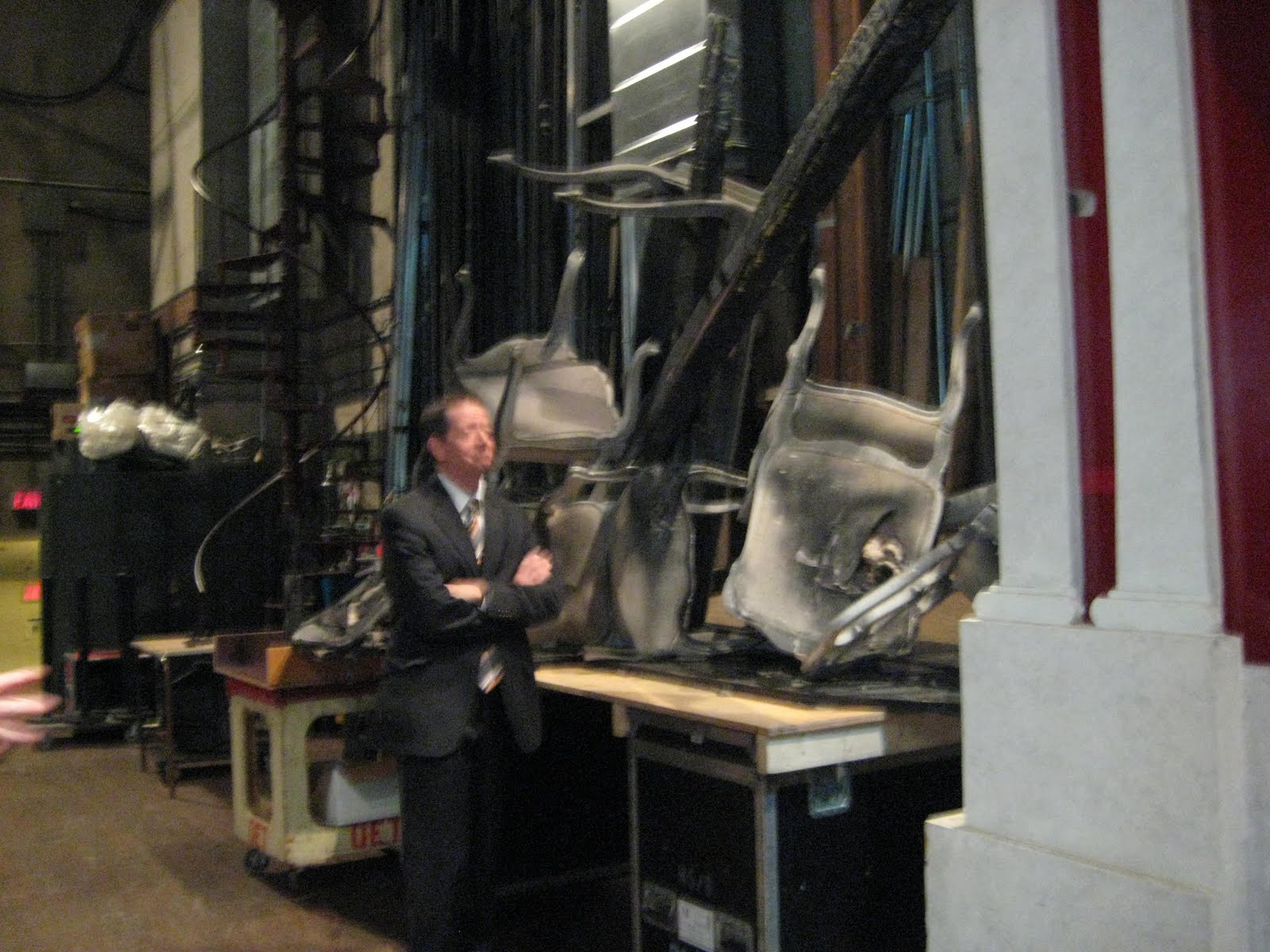 Despite not getting to bed ’til after 1 last night (we went to Bacchus, as usual, for our post opera drink and a late-night snack with our daughters, who kept Paul company while I blogged), I’m up early this morning, still thinking about Clemenza and hearing the music and re-viewing the sumptuous costumes. Last night’s posts felt harried, and I don’t feel I’ve given you an adequate sense of the production yet.
Despite not getting to bed ’til after 1 last night (we went to Bacchus, as usual, for our post opera drink and a late-night snack with our daughters, who kept Paul company while I blogged), I’m up early this morning, still thinking about Clemenza and hearing the music and re-viewing the sumptuous costumes. Last night’s posts felt harried, and I don’t feel I’ve given you an adequate sense of the production yet.
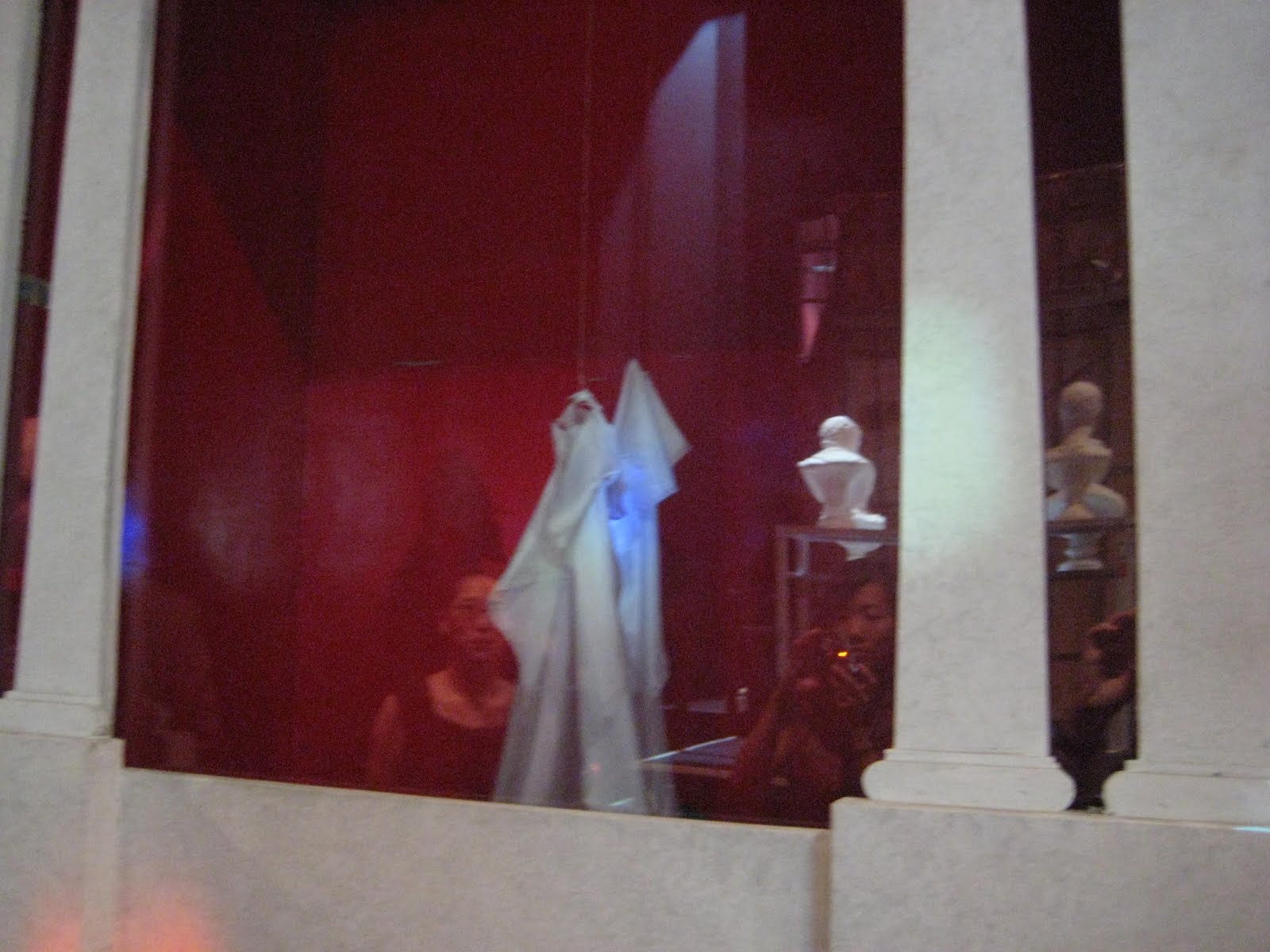 Before the show, we had our usual backstage tour, and again, I have to say I doubt I’ll grow blasé about this soon. I’m not sure if it’s the technology itself that impresses me (and there’s much impressive technology — did you know that the stage manager sometimes uses a night-vision camera to be able to track what’s happening on-stage?) or the contrast between the props as seen in their raw state and their envelopment in, and transformation through, what happens on stage. That contract of suspended disbelief between audience and production mesmerizes me. Above, for example, is one of several units meant to represent burning buildings — the draped fabric you see inside it moves flame-like in changing lights to convincingly suggest a huge conflagration. It’s quite dramatic against the classical white stage.
Before the show, we had our usual backstage tour, and again, I have to say I doubt I’ll grow blasé about this soon. I’m not sure if it’s the technology itself that impresses me (and there’s much impressive technology — did you know that the stage manager sometimes uses a night-vision camera to be able to track what’s happening on-stage?) or the contrast between the props as seen in their raw state and their envelopment in, and transformation through, what happens on stage. That contract of suspended disbelief between audience and production mesmerizes me. Above, for example, is one of several units meant to represent burning buildings — the draped fabric you see inside it moves flame-like in changing lights to convincingly suggest a huge conflagration. It’s quite dramatic against the classical white stage.
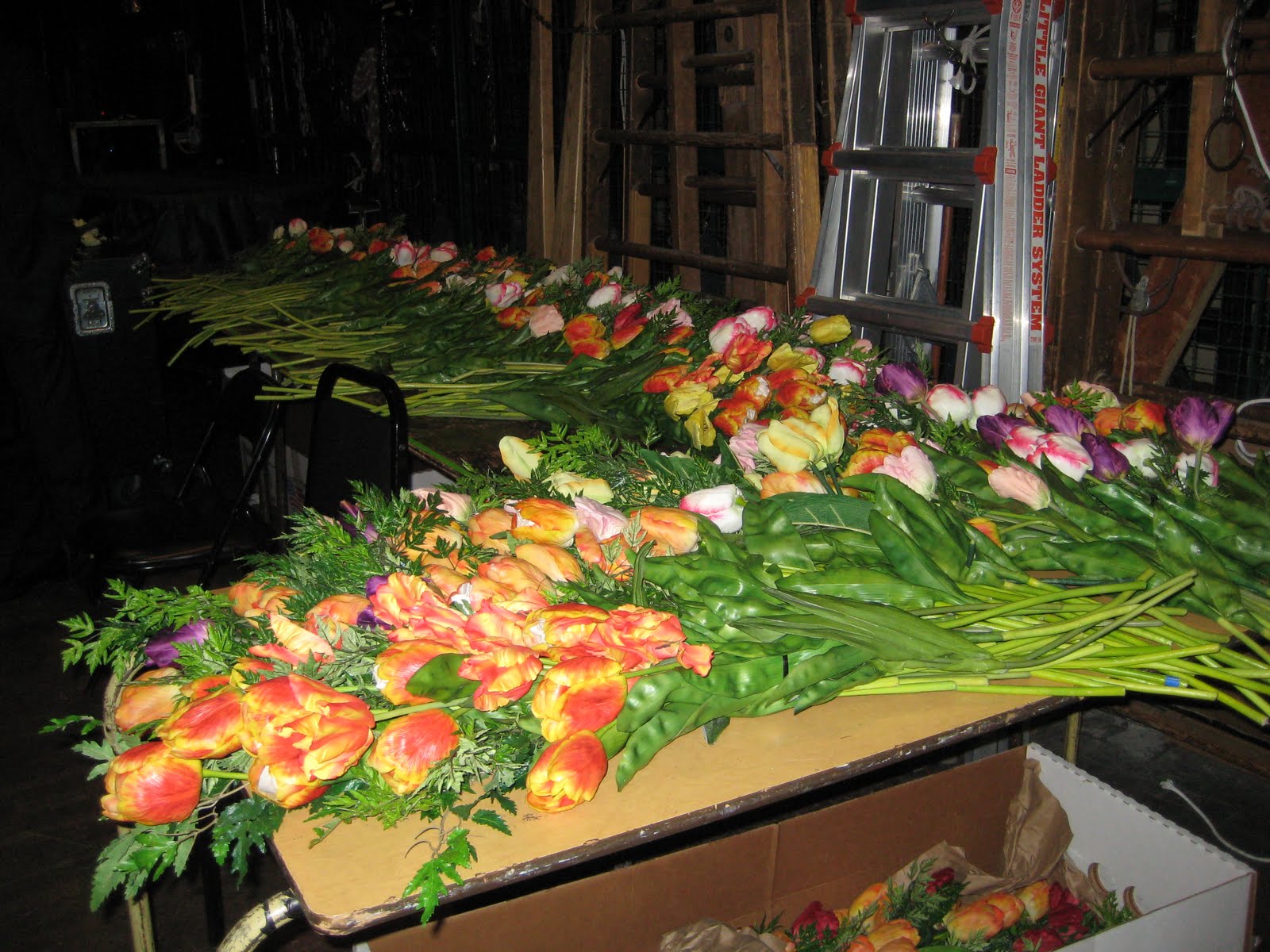 These masses of tulips, offered to Titus to celebrate his nobility, generosity, and mercy, echo the colours of the chorus’ robes — I wish I had a photo of this scene, because visually it was one of my favourites. The robes were in two or three styles of layering for a combined effect of unity but not absolute uniformity. The colours were of satured mid-range richness, and, like the flames, they were a wonderful foil to the neutral background.
These masses of tulips, offered to Titus to celebrate his nobility, generosity, and mercy, echo the colours of the chorus’ robes — I wish I had a photo of this scene, because visually it was one of my favourites. The robes were in two or three styles of layering for a combined effect of unity but not absolute uniformity. The colours were of satured mid-range richness, and, like the flames, they were a wonderful foil to the neutral background.
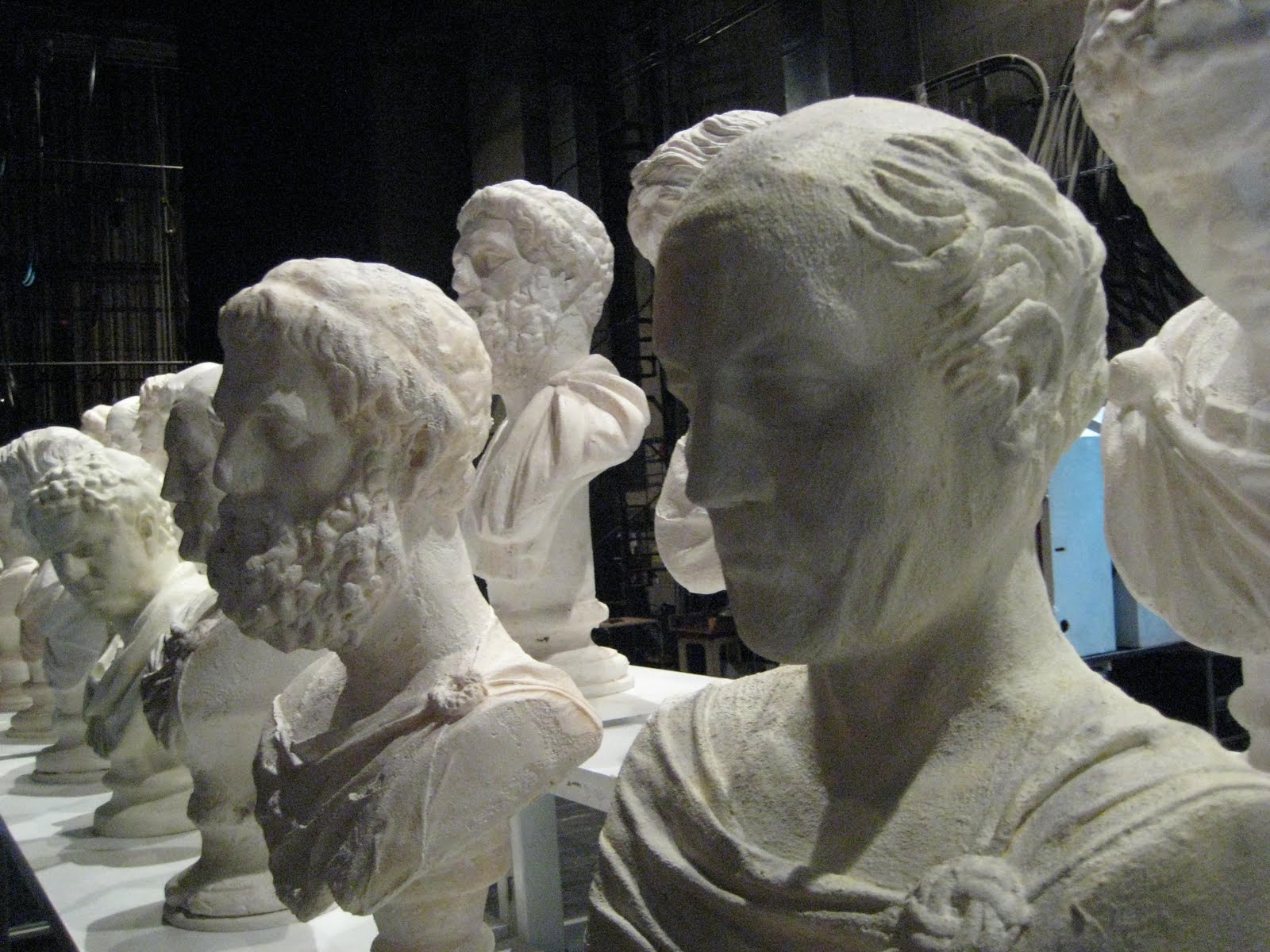 And these busts of the gods, which ranged right across the stage as part of the transformation to Titus’ palace — again that mix of lushness (the sheer numbers, the detailed textures of the busts) and the spare (all in “marble”).
And these busts of the gods, which ranged right across the stage as part of the transformation to Titus’ palace — again that mix of lushness (the sheer numbers, the detailed textures of the busts) and the spare (all in “marble”).
You can see how colour works on a stage like this when you see my fellow blogger, Nik, taking in a little 18th-century seating. . .
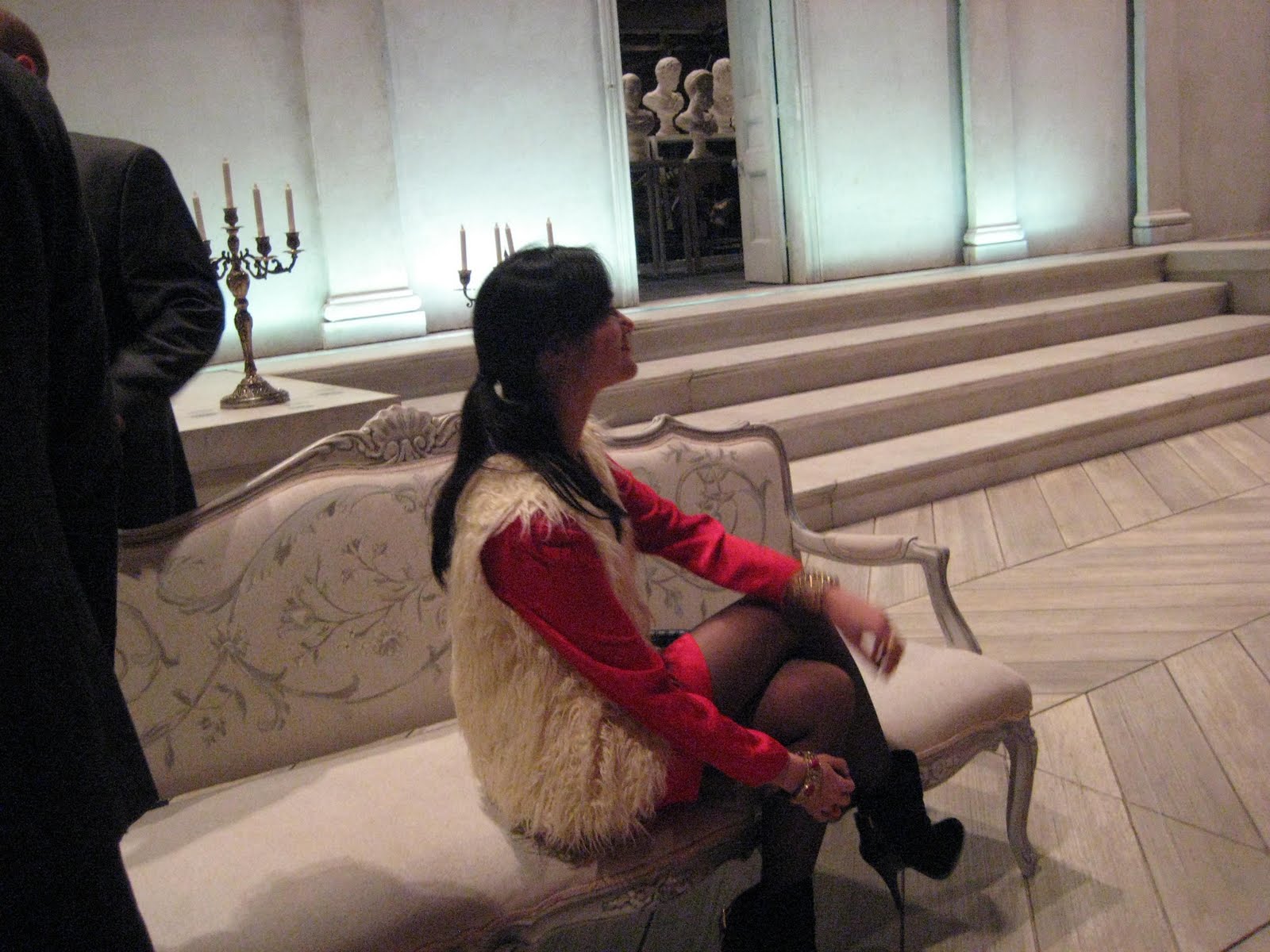 Now picture the main characters in black and white, the emperor and Publius, his guard, in gold, and the chorus, massed in rich sunset colours. Very effective.
Now picture the main characters in black and white, the emperor and Publius, his guard, in gold, and the chorus, massed in rich sunset colours. Very effective.
So there’s a sense of the visual action.
I’ve been thinking since the opera about its play with gender — not in the actual libretto, but in the casting, having two key male roles played by women, their fictional masculinity signalled by their costumes and their mezzo-soprano voices'(and Krisztina Szabo, playing Sesto, is probably my “all-star”pick for the night, along with John Tessier as Tito). I recently read Kathleen Winter’s moving novel, Annabel, about a young hermaphrodite, surgically rendered male, growing up in Labrador, and couldn’t help thinking about that book’s exploration of our insistence on the physical differences, rather than similarities between the two genders.
In writing these male roles, deliberately, for voices outside the normal range of conventional male singers, what was Mozart playing at, or did he simply want a particular sound? And how does the on-stage physicality of the women who play these roles affect our ability or willingness to suspend disbelief and enter the fantasy (always a very tenuous contract anyway, when it comes to opera)?
But finally, what about the music? After all, that’s the bottom-line attraction in opera, isn’t it, no matter how wonderful are the costumes, the stagecraft, the acting?
It’s unfair to compare this opera to Lucia (the VOA’s last production, which I wrote abouthere), but I know my daughters, at least, found it hard not to, and this is not a big, beautiful opera in the same way. But that same dynamic of elegant restraint and lush colour that animated set and costume is found in the music. There’s more recitativo than I love, I’ll admit, but then the arias, and especially the duets, were more welcome to an eager ear. The same was the case when the male voices sang — although I loved the interplay of the soprano and mezzo-soprano voices, the added dimensions of tenor and bass-baritone took on more importance than in most operas, where I tend to take them for granted. It’s as if the spareness of the opera, the stripping down to fewer elements, then teaches our ear to hear and appreciate.
If your ear is ready to appreciate La Clemenza, and you’d like to check out some wonderful costumes and stagecraft, there are still three performances left. Here’s the link for tickets. I’d love to hear from anyone who gets to see this or any other production of Clemenza. And, of course, I’m always happy to have comments about anything here that strikes your fancy.
I have followed the past 3 posts of the Opera…and it's all so exciting…and the sets and those tulips, masses and masses of beauty.
I am thinking that you must be sleeping late today, resting up after all that excitement.
Hope that you have a relaxing day today.
materfamilias, your write-ups are giving me a new appreciation for opera in general, despite not having seen the performances in particular. I'd love someday to attend a performance with you and obtain the benefit of some of your knowledge and insight.
I don't love recitativo either.
One thing I will say about physicality of the women is that if the Soprano is very, very large, I have a difficult time suspending disbelief if she's meant to be the love interest. I know it's not fair, but it's just how I feel, no matter how fabulous the voice. I feel the same way when there are larger ballerinas in smaller companies thudding across the stage.
Hostess: Although I was up way too early (before 6!), I did relax very well today, including a great massage by my daughter, an RMT-in-training. Hope your weekend was lovely as well.
Pseu: Sounds like a plan!
Susan: Since we've been going regularly to the opera, the last five years, I guess, I've been struck by how few of those larger singers are seen anymore. In fact, although I take your point, and it's an important one, I sometimes worry that our "look-ism" must make it hard for some careers, which may be our loss voice-wise. Although perhaps a truly wonderful voice will always make itself heard. I wonder . . .
I'm back, because I worried about offending and want to be really careful about that in writing publicly.
You are right that we may possibly lose out voice-wise. Opera is such an intriguing combination of visual and musical art. The music is what's most important, as you noted, but the visual does matter.
I've seen the same trend — fewer larger singers. I hope it's because the competition is so fierce that we are not losing voice, just extending opportunity to other artists who appeal both vocally and visually.
That said, the voice is its own art form, independent of physical appearance. I shudder to think that in today's opera, we'd possibly miss out on Ella Fitzgerald, because of her size, if we were only able to access her gift via opera and she was blocked due to size.
I do like your idea that the voice will find its way.
In our choir (Episcopal church), we work with young artists — typically graduates of the San Francisco Conservatory of Music — and feel passionate about supporting them in their vocal careers, including hosting fund raising recitals at our home or other venues. The singers come in all shapes and sizes, and that's actually part of the fun!
frances! always nice to see you! 🙂 i had a lovely time blogging with you and stacey. you should have stayed for the after party on stage, met some of the singers, but i know bacchus was calling! luv ur post. ps- i like the pic of the girl in the red dress. 😉
nikjillb.blogspot.com
I have to say the more of these posts I read the more tempted I am to dip a toe in the opera world. I would have to start with Mozart of course; I love a melody, no matter how many notes! And lets face it living in London I have no excuse.
I too am mesmerised by the mechanics of the stage, for me it's as much part of the experience as the play itself. I once went to see a play at The National where the stage was applauded each change over, deservedly so.
Susan, yours is such a thoughtful voice I can't imagine you offending. The work you do with young musicians sounds very rewarding — both important and exciting to nurture them at those early stages of their careers.
nik: Yes, Girl in a Red Dress, such a striking photo, such a striking girl!
Alison: Ah, the London stage . . . and yes, you should get yourself to an opera, I agree!
frances! i posted my pics from the opera. i think you'd like to see them. i hope you don't mind i tell a little story about your mishap with the curtains. haha..it was so cute! and vivian captured my reaction so well. :)))
nikjillb.blogspot.com
I love your opera posts and you manage to capture the excitement of being there and share the experience in a way that makes everything very real, and more than just words on a page, Magical.